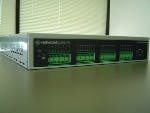Redwood Systems brings network-powered approach to LED office lighting
Redwood Systems based in Fremont, CA emerged from stealth mode with a new network-centric approach to LED lighting in commercial environments that's driven by a team out of the computer networking industry. The company plans to deliver energy savings by consolidating the LED power source, distributing DC power and control signals to fixtures, and relying on efficient LED technology.
Although product specifics won't come until Lightfair in Las Vegas this May, Redwood is conducting ongoing field trials of its technology. VP of Marketing Jeremy Stieglitz claims the technology-heavy approach can deliver a return on investment in two years for commercial spaces. The company claims its technology will deliver more than 90% of the input power to the LED.
Lighting is a huge component of the energy bill for most commercial enterprises, and is the reason for the recent surge of interest in LED lighting that uses less energy than alternatives such as fluorescent. Redwood wants to extend the savings by remotely controlling each light, ensuring that lights are only on when required.
Referring to businesses, Stieglitz states, "Lighting is 20% to 40% of their energy load and they have no visibility into it." He claims that businesses want to cut energy cost and want better instrumentation in the lighting plant.
Redwood's technology will provide both the ability to control the lights and to monitor energy usage at each light and other operating characteristics such as temperature. Stieglitz stated, "We will offer richer sensor distribution and more control at each light."
The control aspect includes dimming lights when workers leave an area and tuning lights to a task. The system could also optimize energy use based on utility rates and pricing programs. And the instrumentation capability allows management of lumen depreciation and ensures the system doesn't over-drive the lights.
The Redwood scheme will only be applicable in new construction or major remodels because it relies on a new way to distribute power to the lights. The company will offer centralized light driver systems that distribute DC power and a network link to each light.
Given the founding team's heritage in the network space, the system functions similarly to a computer network switch in a wiring closet. Installations will even link the central systems to lights via network cables in some cases.
A single pair of wires will carry both the constant-current DC power needed to power a light and a proprietary power-line communication network. For cable runs of 100 to 200 ft, the Category 5/6 cable used in networks can deliver the required 350 mA of current at 60VDC – meaning the system is classified as a low-voltage system from a regulatory perspective. For longer runs to 100m, the system will relay on moderately more expensive 18-guage wiring.
Centralizing the power supply offers several potential angles towards system cost savings and ROI. A single PFC (power factor correction) front-end stage supplies a DC voltage to each light channel where dedicated DC/DC converters drive the lights. Stieglitz claims the centralized PFC stage offers an 8:1 advantage relative to having a PFC stage at each light.
Down the road, Stieglitz claims the cost comparison tilts more in Redwood's favor. He sees the IC driver manufacturers developing multi-channel DC/DC converters that increase the level of integration in the system. Moreover green technologies such as solar and fuel cells produce a DC output that could directly drive the system, eliminating the inefficiency in the DC/AC inverter and subsequent conversion back to DC at the legacy LED luminaire.
The centralized approach also offers a system cost advantage when it comes to control. Stieglitz points out that a single FPGA IC can implement 64 dimming curves each with 65,000 steps – one for each of the 64 channels the initial system will support. Stieglitz claims that the system offers "best-in-class dimming" at what is essentially a 20% to 30% cost saving at the individual fixture level.
The challenge for Redwood will be the complete transition to a new power distribution scheme. Surely some building engineers would prefer a move to the savings afforded by LEDs while maintaining the legacy AC power-distribution scheme.
Stieglitz states, "You can't be disruptive without creating pot holes." But he believes the energy savings afforded by the centralized DC approach will win out in new construction or remodels. He stated, "I've seen a willingness to take on more change and more risk than I ever would have expected."
LED and lighting manufacturer Cree lends credence to the Redwood approach. "Redwood Systems has the potential for a new and better way to power and control LED lighting that could add significant intelligence to lighting systems and accelerate customer ROI through energy savings and reduced installation costs,” said Gary Trott, vice president of market development of Cree."






